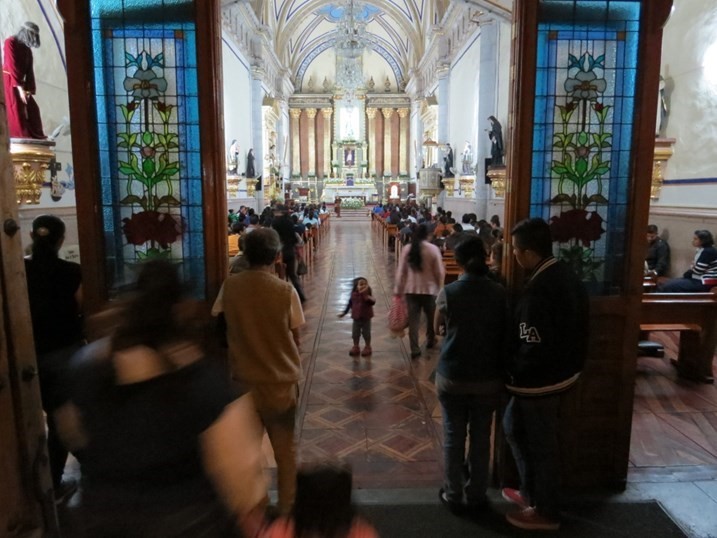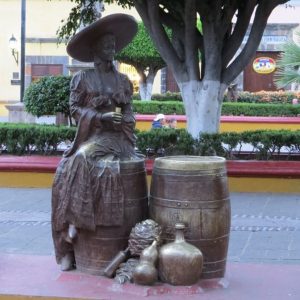By Ken Waldie from the February 2019 Edition
From Manzanillo, it’s a long climb up to Lake Chapala at 1,524 m. or 5,000 ft above sea level, but the climb is so gradual, it’s indiscernible. Even a short distance from the coast land and weather can change from humid to arid, and warm to cool, very quickly.

Most of the northern and central interior of Mexico is actually a high plain known as the Altiplano (north and south). It extends from the US border to the Trans-Mexican Volcanic Belt (the Sierra Nevada) in south-central Mexico and averages some 1,800 m or 6,000 ft. above sea level.
The rugged highlands north of Guadalajara, bounded with steep mountains and chasm-like valleys, have required brilliant engineering, evidenced by beautiful (and very high) bridges and trestles that cross through this extremely tough terrain.

It’s deceiving travelling through this region because you don’t realize just how high the passes are until you start the long drive down into the valleys below. As mountains melt away and broad valleys open to wider, gentler slopes, splashes and then swaths of teal-blue coloured agave coat the hills, reaching right down to the roadside. The region grows some 30,000 hectares of agave, that’s one great, big coat there…
Gracing the valley bottom still 1193 m up (that’s 3900 feet) is a lovely town whose main industry is world famous. Santiago de Tequila, Jalisco, is where tequila is made. Tequila’s whole existence, with the long history of its production, reaching back into Aztec times, with street-side statues, artwork and tequila outlets, is one of those remarkable places that make me glad I stopped to take a look. It’s an industrial town with charm.
Tequila’s two main producers, Jose Cuervo and Sauza are only a few blocks from the central zócalo. Both distilleries, and most of the boutique distilleries nearby, offer regular tours of their facilities and tastings, of course. You can take a bus tour on bottle-shaped buses or you can go fancy and hop on the Tequila Express or the Jose Cuervo Express, two trains, running from Ajijic or Guadalajara, to tour through the mountains to Tequila and back. On board, travellers enjoy authentic food, tequila tasting, music and an opportunity to learn about tequila.
We found our way, from our hotel, down the street, to the Sauza distillery. The tour began in the Sauza garden, a very large area that I guess is about 6 or 8 city blocks square and is graced with many statues and sculptures, with at least 4 chapels in different areas of the garden; it’s worth a look all on its own.
Our tour of the distillery was fantastic. We went from a storage area, where wee samples were distributed, through to the agave crushers, the boiling vats, to the heart of the distillery where they brew the tequila of up to 100 proof or better. Our guide, smiling, gave us some small samples…we all had to watch our step till we got our equilibrium back after that. From the 100 proof, tequila is reduced by about half, and aged to become the product we know.

There are several boutique hotels available in town, some surprisingly large, but hidden, behind a humble street facade. Our last stay was at Hotel Plaza Rubio, a modest accommodation with a beautiful garden plaza in the middle and within easy walking distance of the town center.
It’s a pleasure to wander down Tequila’s cobblestone streets. The main parish church, Our Lady of the Purísima Concepción, was built in the 18th century and sits in the town center. On our previous visit, we were there having dinner in the church plaza or zócalo, when, as it turned out, it was Ash Wednesday. At the end of the service, the congregants came out all with black crosses smudged on their foreheads. The spectacle seemed a little strange, like a zombie apocalypse, but with happy zombies wandering around.


Into the night, many businesses stay open. The tequila emporiums, many very large, have more varieties of tequila than I ever thought existed. They look almost like glasswork factories. There are so many different bottles glistening in the display light. Of the top 5 most expensive brands, some are fairly affordable, according to top10zen.com, in 2014 prices: Don Julio Real – $350, Tres-Quatro-Cinco $390, Barrique de Ponciano Porfidio – $2,000, Dos Luna’s Grand Reserve – $2,500, but the MOST expensive bottles of tequila weigh in at $225,000 and $3,500,000 respectively. And these prices are in USD!
Ultra-Premium Ley .925 Pasión Azteca makes them. The cheap one is presented in a platinum and white gold bottle, with a solid platinum logo, and the granddaddy is similar, but it is covered in diamonds.
Tequila is a pretty little working town and certainly worth a stop to see. Half the fun was in the getting there. It’s an adventure, whether by Guadalajara or from Puerto Vallarta up the coast through Sayulita, Bucerias, Nayarit and into the mountains.
If you have several days, and two tanks of gas, you’ll have a grand adventure.
The full edition or view it online



